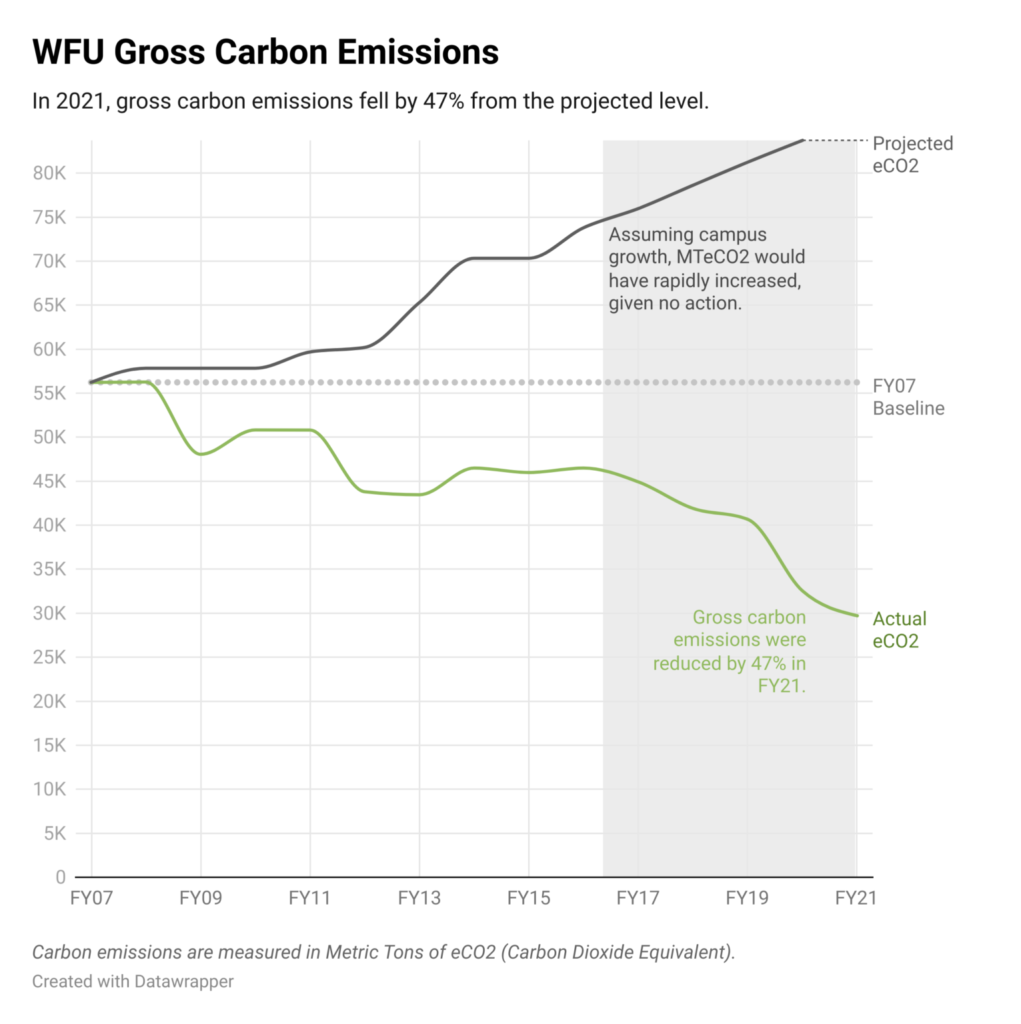On the Road to a Carbon Neutral Wake Forest: The Team and Strategies Making It Happen

During November of 2021, 120 leaders from around the world convened to discuss the state of Earth’s climate and deliver real progress on climate action at the 26th United National Climate Change Conference (COP26). Eyes all over the world watched as more than a month of panels, discussions, and negotiations unfolded on a global stage. The outcome of this conference–and additional formal and informal work and engagement over many months–was the Glasgow Climate Pact. This is the first climate agreement explicitly aimed at reducing unabated coal usage in an effort to reduce greenhouse gas emissions and keep global climate change within a critical threshold of warming, as laid out by the Intergovernmental Panel on Climate Change (IPCC).
In order to meet the goals set forth in global-level policy and pledges, much action is required on the local level. States, cities, municipalities, and even universities hold great power in spearheading the necessary initiatives, growing green infrastructure, and conducting community outreach and engagement in order to reduce CO2 emissions. According to the United Nations Framework Convention on Climate Change, “thinking and acting at a local level helps communities fight climate change and build resilience to climate impacts.” Cue Wake Forest University’s carbon action planning initiative.
Through cross-community collaboration between Facilities and Campus Services, the Office of Sustainability, and other key stakeholders, our campus has made a bold pledge to be carbon-neutral by the year 2040– ten years earlier than most contemporary universities and organizations. Carbon neutrality refers to maintaining a balance between carbon emitted and absorbed. Carbon neutrality is a critical step in meeting the goals set forth by the Glasgow Climate Pact as we approach an increasingly dire turning point in Earth’s climate.

Compared to 2007, the first year for which robust carbon data exists on campus, Wake Forest has seen a 47% reduction in carbon emissions, despite the physical footprint of university buildings growing substantially. This initiative is a collaborative effort to implement impactful changes at Wake Forest to steer us the right direction in terms of climate action. Jimmy Nifong, Assistant Director for Utilities Operations, shared that when he joined the team 12 years ago, he “always had carbon on the mind. It was nailing down achievable goals and a plan to get there that led to the beginning of the project.
When Doug Ecklund joined the team as the Assistant Director of Building Systems, he saw an opportunity to take energy initiatives a step further by looking at metrics more frequently. After the university set the carbon neutrality target, the Facilities team launched the Building Performance Improvement Initiative, or BPI2, a five-part plan to meet their goals. Operational components include structural improvements such as analytics and metering, behavior-based efforts, and communications targeted to members of the campus community.
Metering, analytics, building scheduling, communications, and behavioral targets are at the core of the initiative and allowed for the 47% reduction. Metering allows for each building’s electrical power, water, steam and chilled water usage to be accurately measured and related energy reductions clearly reported. Analytics refers to installed systems in buildings that proactively notify Facilities of any issues and allow technicians to address them immediately and prevent unnecessary energy consumption while also keeping building occupants comfortable. Building scheduling decreases energy consumption by reducing or shutting off heating, ventilation, and air conditioning (HVAC) and lighting systems during unoccupied periods. Finally, communications and behavior-based initiatives are vital to educating the campus community and maximizing the impact of the structural improvements. The Facilities & Campus services team shares that
“With more than 20 past projects totaling a savings of over 5 million kilowatt hours [of electricity], and with more to come, this initiative is a driving force behind WFU policy, budget, and behavioral changes that make a difference in every Demon Deacon’s life.” (WFU Facilities & Campus Services)
Nifong and Ecklund share that communications and behavior-based initiatives represent ever-evolving projects in themselves. Nifong says “getting each new class to understand how they can help with energy [reduction] is an effort we have to undertake every year and we have to work to remind upperclass students too. Getting the message out on campus is always a challenge.”
In regard to structural initiatives undertaken by Facilities, “energy efficiency is always in mind, which directly relates to less carbon” explains Ecklund. From retrofitting and renovating buildings around campus, to integrating more efficient heating and cooling strategies, to using timed lighting systems, efficiency of these and other systems is pivotal.
Looking forward to future opportunities for reductions, Nifong shares that “renewables will have to come into play whether that is on site or an offsite project”. Lindsay Batchelor, Director of Sustainability at Wake Forest, remarks that reaching carbon neutrality ultimately “relies on a carbon reduction hierarchy of avoiding emissions, reducing emissions, replacing emissions (i.e. renewables), and lastly offsets. ”
It is important to imagine the progress of WFU’s carbon project within a much broader context, especially in the wake of COP26. “Climate change is speeding up faster than anyone thought,” says Batchelor. “This is a quickly changing landscape as we see climate impacts coming to the forefront. How do we move a little faster than we thought we were going to need to move?”
Ecklund and Nifong are up for the challenge, though. Ecklund shares, “The strides we have taken on campus are significant in a short amount of time.”
“We are ahead of the curve when you compare us to the global community. This is our role as a place of higher education.” concludes Batchelor.
To learn more about Climate Action at Wake Forest, check out https://sustainability.wfu.edu/initiatives/climate-action/.
